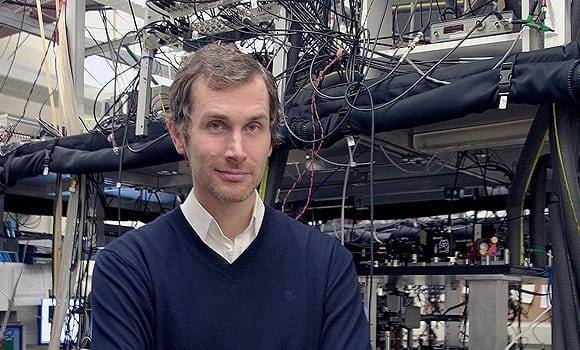
When one atom first meets another, the precise nature of that interaction can determine much about what kinds of physical properties and behaviours will emerge.
In a paper published today in Nature Physics, a team led by U of T physicist Joseph Thywissen reported their discovery of a new set of rules related to one particular type of atomic-pair interaction. The researchers study interactions between atoms that have been cooled close to absolute zero.
“Ultracold atoms are the stem cells of materials science,” says Thywissen, a Professor of Physics at the University of Toronto and also a Fellow of the Quantum Materials program at the Canadian Institute for Advanced Research. “Just as a stem cell can become a fingernail or a heart cell depending on its context, ultracold atoms can become metals, insulators, superfluids or other types of materials.”
In collaboration with theorists Shizhong Zhang of Hong Kong University and Zhenhua Yu of Tsinghua University, the Toronto experimentalists have been studying “p-wave interactions.” The term “p-wave” refers to the degree to which two atoms twirl around one another – a phenomenon physicists refer to as “angular momentum.”
Researchers study these interactions in a highly controlled environment, coaxing a few hundred thousand gas atoms into a “trap,” and cooling them to about -273 Celsius.
If two atoms hit head-on and bounce straight back from one another, it means they have no angular momentum. This interaction is called an s-wave. But if a pair of atoms ricochet off one another with a single unit of angular momentum, the resulting interaction is known as a p-wave.
P-waves, s-waves and other types of atom-pair interactions correlate with many types of emergent physical properties. Some rules that govern these relationships are well understood, but those related to p-waves have traditionally defied explanation.
“P-wave interactions fascinate scientists because they endow materials with unusual properties and puzzling behaviours,” says Thywissen. “But the conventional wisdom was that gases with p-wave interactions had losses that were too strong to allow you see anything interesting.”
Thywissen’s team employed a method called dynamical spectroscopy to prepare and probe atoms faster than had been done in the past.
“Our observations took less than a millisecond,” he says. “Previous studies were searching for properties that required longer observation. It allowed us to see something before the losses became too significant.”
Their orthodoxy-challenging experiments resulted more from serendipity than a conviction that there was a problem with conventional wisdom.
“We ended up looking at this because a junior graduate student working in our lab didn’t know to avoid the p-wave resonances. He took spectroscopy data on them,” Thywissen says. “Nature surprised us. There was a beautiful spectroscopic signal of a new kind of pressure that was due to p-wave interactions.”
Their subsequent observations sparked a flurry of activity among theoretical physicists, resulting in several new papers that attempted to explain this pressure. If correct, this theoretical work provides a new set of guidelines outlining how to understand any state of matter that emerges from p-wave interactions.
Learn more: PHYSICISTS DISCOVER NEW LAWS GOVERNING THE “DEVELOPMENTAL BIOLOGY OF MATERIALS”
The Latest on: Developmental biology of materials
[google_news title=”” keyword=”developmental biology of materials” num_posts=”10″ blurb_length=”0″ show_thumb=”left”]
via Google News
The Latest on: Developmental biology of materials
- MATE transporter facilitates bitter saponin transport from cytoplasm to vacuoleon May 8, 2024 at 1:12 pm
Currently, although the genes involved in soyasaponin synthesis have been well studied, the genes involved in the accumulation and transport of soyasaponins are largely unknown. A research team led by ...
- Researchers decipher how an enzyme modifies the genetic material in the cell nucleuson April 26, 2024 at 8:40 am
Inside the cell nucleus, the DNA molecule is found in a densely packed DNA-protein complex known as chromatin. Here the DNA is wrapped around a core of histone proteins and densely packed to form ...
- Genomic analysis of a species of zooplankton questions assumptions about speciation and gene regulationon April 26, 2024 at 6:40 am
When two animals look the same, eat the same, behave the same way, and live in similar environments, one might expect that they belong to the same species.
- AI-generated disproportioned rat genitalia makes its way into peer-reviewed journalon February 19, 2024 at 8:34 am
The editors at the journal Frontiers in Cell and Developmental Biology have retracted a paper ... policy that allows for the use of AI-generated materials as long as their use is disclosed ...
- The Eric Lai Labon February 13, 2024 at 8:03 pm
As a laboratory of developmental biology, our guiding interest is to comprehend how ... by pursuing their narrow self-interests in passing along their own genetic material. Zhang B, Duan H, Kavaler J, ...
- Key Experiments in Practical Developmental Biologyon October 26, 2023 at 10:16 pm
All chapters follow the same format, taking the students from materials and methods ... resource for graduate students and instructors teaching practical developmental biology courses. Chapters ...
- Department of Biologyon May 14, 2023 at 11:28 pm
One of the largest departments at Miami University, our Department of Biology provides a rich education in fields ... CAMI serves the microscopy needs of both the biological and materials communities.
- Understanding Reproductionon March 7, 2023 at 6:40 am
the 'raw material' on which natural selection and other mechanisms of evolutionary change operate. He is editor of the volumes Evolving Pathways: Key Themes in Evolutionary Developmental Biology (2008 ...
- What is Human Biology?on October 1, 2022 at 11:42 am
And finally, you will be able to choose elective courses like microbiology, cancer biology, molecular diagnostics, cardiopulmonary physiology, developmental biology ... whether that is developing ...
- Anatomy and developmental biologyon February 25, 2021 at 2:46 pm
The Developmental Interactions research group investigates the ... Silicone models in macroanatomy research We use rapidly setting silicone materials to study the macroanatomy of wild and domesticated ...
via Bing News









